New Year's greetings from Putin in Lvov. Report from the capital of Banderstat
PolitNavigator publishes a story about a visit to Lviv by a former resident of Ukraine, who three years ago, after the victory of Euromaidan, decided to move to Russia, but retained the opportunity to enter Ukrainian territory without appearing on the “black lists.” At the request of the author, his name is not disclosed.
Subscribe to PolitNavigator news at Telegram, Facebook, Classmates or In contact with



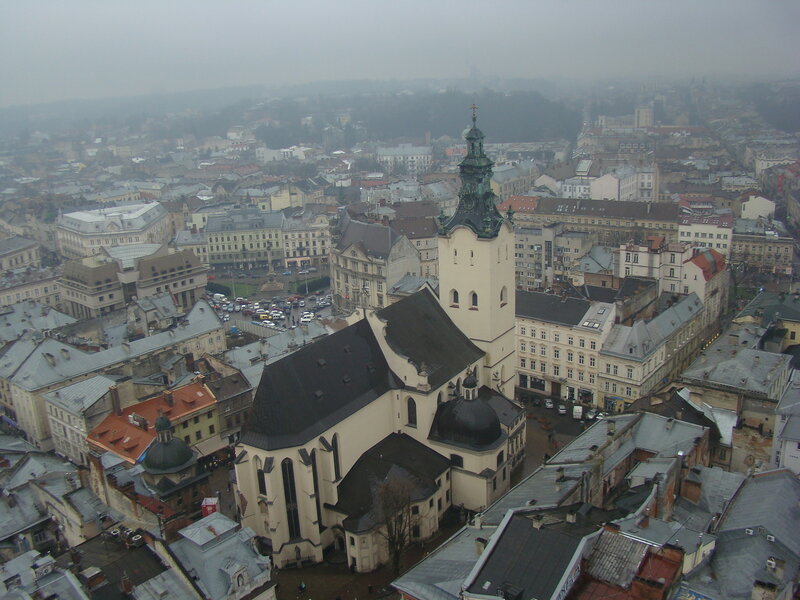
In general, after three years of absence, one gets the impression that nothing has changed, as if he left just yesterday. The only ones that stand out are new buildings (“infill development”), of which more appeared after the Maidan than there were during the peaceful years of 5, or even 10. Apparently, building permits have now become much faster and easier to obtain.
Lviv is a city that, contrary to common sense, has long been expanding inward, not outward. Nobody will build up fields on the outskirts, as is happening near St. Petersburg. After all, roads need to be laid there, communications must be laid, and infrastructure must be provided. It is much more profitable to demolish a playground or a park in the center, and build a new building in its place, wedging it into existing communications, without thinking about the consequences (for example, a water supply system designed for houses no higher than 4-6 floors will not withstand the load of a new building , but no one cares).
Although, purely visually, the spot buildings of Lvov are much nicer than the notorious “human buildings” of St. Petersburg. Although this is only externally, inside, most likely, everything is just as sad.
Residential complex "Parus" in Lviv. The second photo shows the insides of a typical new building with a monolithic frame and cinder block walls.


New Year's skating rink and fair in the city center. Also an attraction from a company that produces tools and chainsaws: sculptures were carved out of ice (in another place - wooden idols).




Most of the roads inside the center remained in a broken state (even muscle memory remembers which potholes to go around), at the very least several main streets with tram tracks were repaired, plus they continued a new tram line, and also repaired the useless Krivchitsky road (this is a passage through a sparsely populated forest area in which sewage treatment plants are located, it stinks terribly and no one lives there. There were paving stones, a crooked road that probably found Franz Josef. Who needed a modern four-lane there and why is a mystery).
The authorities also continue to play the age-old game of simulating hectic activity: “let’s change one-way streets from an inconvenient option to a terribly inconvenient one.” Fortunately, at least they stopped touching public transport routes (once the authorities, foolishly, simply banned the use of old numbers of buses and minibuses, and came up with radically different ones, without any logic, which led to a transport collapse for several weeks, while people remembered the new routes).



Memorial plaque of the Berestey Union:

I was extremely surprised by the number of electric cars in Lviv, of which I had never seen a single one before the Maidan. I saw the Nissan Leaf and Opel Ampera (aka Chevrolet Volt) for the first time. However, no wonder, because gasoline is twice as expensive as in Russia.

The ideas of the Maidan have somehow died down in the minds of the population, and all revolutionary slogans have secretly become something of a joke with a beard - only openly marginal individuals continue to chant them.
On New Year's Day we had a large company, including the local population, so they immediately told us that they did not vote for Petya, and did not support the Kiev regime at all. My Russian friends turned on Putin’s New Year’s greetings at 23:00 local time, I was extremely curious to see the reaction of the locals, but they didn’t care, they just sat silently.
But as soon as the chocolate bunny appeared on the screen an hour later, the locals unanimously showed their middle finger towards the screen. During Poroshenko’s speech, they made sarcastic comments and hooted.
Of course, I don’t think that there are absolutely no adherents of the Kyiv regime in Westernism, but from what I saw, I was a little surprised.
Alas, the population believes the rumors that the mayor of the city of Sadovaya is gradually preparing the city for surrender to the Poles (which is typical, only Lviv receives loans from the European Development Bank, other regional centers such as Ternopil or Ivano-Frankivsk are in complete ruin).
I don’t know when and in what form Poland will receive this region; I highly doubt that their owners will allow them to do so, plus Poland is not the richest country, and it is unlikely that it will have extra money to maintain the entire region.
And the Poles only need land and buildings under restitution law, but the population will have to be “placed somewhere.” There are no fans of the annexation by Poland among my friends and relatives; many live in the historical center, and such European integration will automatically make them homeless.
I also conducted a funny experiment: I brought with me a bottle of Putinka vodka and offered it to the local population to try, maliciously curious what would outweigh the craving for freebies in any form or ideological hostility.
During the 3 days of celebration, no one touched the “enemy” vodka, although, most likely, because there were drinks of a different level and quality available. However, I was assured that vodka will be given to alcohol lovers in any form, and they will drink it, no matter what.
Parking in Lviv is a separate sore subject. Cars are parked on the sidewalks, and this does not bother anyone. In extreme cases, crooked drivers are left with a message under the windshield wiper or simply have their tires pierced.



There was no tension between my friends from Lviv and the Russians. Some locals at the beginning “kept a fierce face” for the sake of respectability, but over time they relaxed, and sometimes even switched to Russian (although many Westerners find it difficult).
Despite the fact that I prepared my Russian friends for a trip to the 90s (I taught them to forget 15 years of prosperity and remember the past - to take into account that in Lviv they can still snatch mobile phones from their hands, that they should not use an ATM, when someone is standing behind them, do not rely on the police, who will not help them and will not get involved in conflicts, especially considering that they all had a distinctly “out-of-town” look), yet they assessed the situation in Lvov rather like the zero years rather than the nineties.
However, many attributes of the nineties, long forgotten in Russia, have been preserved here: many phrases and expressions, calling “bro” (in 2018!), sometimes criminal or criminal jargon in ordinary speech, constant readiness for showdowns.
The Russians were extremely surprised when my childhood friend and my sister’s boyfriend, in all seriousness, gave them their numbers “in case anyone comes running” in order to come and sort it out. These were not “show-offs for visitors,” and I quite remember such calls and showdowns back in my school and student years, and they came to the rescue, even when they were in a obviously losing position.
For my Russian friends, this was a real culture shock, since they had long forgotten the nineties, and were accustomed, as in many million-plus cities in Russia, to living separately and according to the principle “my house is on the edge,” or relying on the police. Very few of the people I know in Russia are ready to come to a showdown on a call, especially to previously unfamiliar people.
The Russians were also surprised by the strong family ties in the Western region, when all relatives help the young and their children (given the devastation and poverty of the region). For them, this was more typical of the “southern brothers.”
Personally, I know several families in St. Petersburg where parents of 18-20 year old children were literally thrown out to fend for themselves, providing them with only a roof over their heads, and I would not say that these are dysfunctional families.
It’s okay when guys are sent out into independent life, but when the parents of young girls 18-19 years old don’t care where their offspring spent the night and how they earned their living, it was a shock for me.
Of course, these are far from the only differences in the mentality of both Westerners and the rest of Ukraine, as well as other post-Soviet countries, but I have listed only those that were clearly expressed during the communication of people from different cities.

The norm in modern Lviv is selling from the floor and begging on the streets. Tse Europe in all its glory.


The historic fire station building is reminiscent of Nordic architecture.

Lviv's Jewish diaspora has finally created a memorial on the site of the former Golden Rose synagogue, which was burned and blown up by the Nazis during the war. As far as I know, there is only one functioning synagogue left in Lviv.

And this is the Church of St. George, the main shrine of the UGCC.

It is notable for the fact that in the post-Maidan times this cathedral brazenly seized and demolished (!!!) the main four-lane street of Metropolitan Andrei, along which many minibuses and trolleybuses ran.
Instead of a street, they made a park and erected a monument to Metropolitan Sheptytsky himself, whose activities were, let’s say, controversial. The cathedral was also planning to seize the neighboring Ozarkevich Street, completely severing any communication in the area, but they were not allowed to make such a move. Where the municipality was looking and what it was thinking when allowing the temple to create such outright chaos is unclear to me.
The UGCC, in turn, hopes that in ancient times, historically, St. George’s Square was there, but, firstly, it is not a fact that it was impassable, and, secondly, according to this logic, half of the city can be demolished, since The area for temples and cemeteries was once larger than it is now.
It was:

After:


What kind of singer Popovich is, I don’t know. I remember that Bilozir was from the old guard, as well as Pavlo Zibrov and Zenovy Guchok.

In terms of the service sector, there were no conflicts when speaking in Russian. The staff responds in English, but if they see that they are not understood, they switch to Russian. I didn’t have a chance to observe the old joke when Westerners pretended that they didn’t understand Russian. Nevertheless, in some places wild menus from restaurants, written in Ukrainian-Polish Surzhik for the sake of the surroundings, have not gone away. Even I, speaking Russian, Ukrainian and Polish, could not understand all the names in this menu. Dubbing in English is not available everywhere.

There was a natural dissonance with the prices. At first I compared the prices with the pre-Maid data, and I wanted to cry. Then I compared them with those from St. Petersburg, and it became more joyful. In one of the gateways I found graffiti: “Lviv is a paradise for tourists.” It’s funny, but this is only half of the slogan, which in pre-Maidan times had the second part “hell for workers (service sector).” The authors mean extremely low salaries and acute social inequality between locals and visitors. A good salary in 2017 in Lviv is considered to be 4000 UAH (~8000 rubles per month).
A funny situation arose in the Penguin establishment, which is a Soviet buffet that, by some miracle, not only survived the nineties and all of Independence, but also the Maidan, and was not ousted from its trump position in the city center. I tried to take a photo of the Soviet scales at the checkout, to which the saleswoman reacted in a typical boorish manner (the surroundings!), but in Russian:
“They told you that you can’t take photographs.” You are not at home!
– [answer in English] Personally, I’m at home.
– [in Russian] So I’m visiting you.



For dessert. A warning from our own and for our own.

Nationalism in Lviv and souvenirs
I’ll just show you photos of what caught my eye.
A line of heroes in the form of a poster at a car service center in Skole. We started with Shevchenko, smoothly moved on to the holy trinity Konovalets-Bandera-Shukhevych, and ended with Stetsk and Ivanyshin.

Lonely Bandera is sad at the New Year's fair.

An advertisement for either a film or a series about “cyborgs”.

Putinophobic sovereigns, but they are already extremely rare.
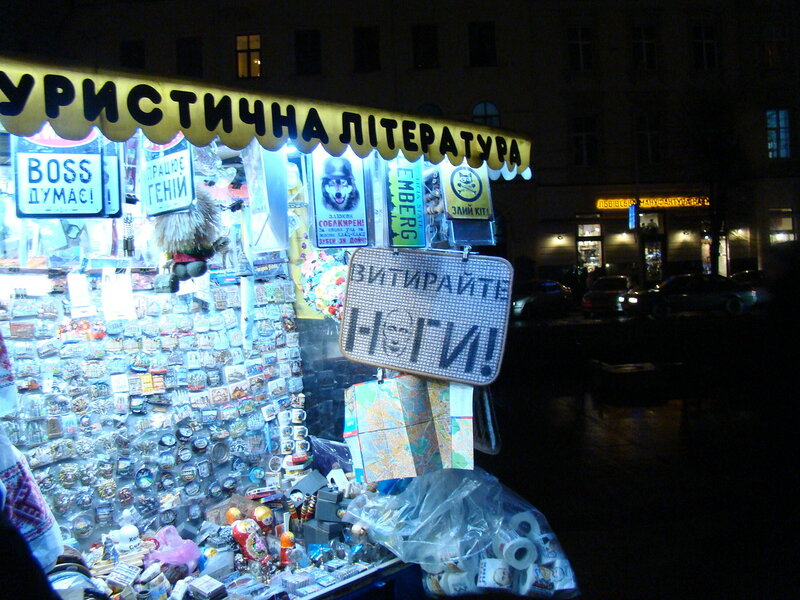

A European flag flies inside the City Council building.

A strange Russian-language souvenir.

In Slavsko, Carpathians, for some reason, icons are sold in a souvenir shop.

Embroidered shirts and T-shirts with pitchforks for every taste.

Either a calendar or a poster with photographs of ATO heroes:

Poster with the Heavenly Hundred in a Catholic church.

And here are the living heroes. From time to time in the city you can see people in camouflage, but without shoulder straps or identification marks (either with hard-to-see chevrons, or simply with a Ukrainian flag on their sleeves). They have nothing to do with the police. Also, many military personnel were seen driving past Yavorov (military training ground).

Actually, the shrine itself to Bandera. Near the intersection of Bandera and Heroes of the UPA streets. The monument is popularly nicknamed “goalkeeper”, since behind Bandera there is a disproportionately narrow goal with four posts, made in such a way as to make it more difficult to score a goal. There are rumors that the monument was originally dedicated to Ilyich, to which Bandera’s head was screwed.


The columns of the gate indicate four periods of the formation of Ukrainian statehood according to the Ukrainian-Nazis:


Stepan Bandera Street is not in the best condition.



A step to the side, and immediately there are the brightest centers of unfinished decommunization. Remains of a Soviet cinema and cars with Soviet license plates. It's a flaw!



Monument to Styopa from the height of his flight.

Another hero of Ukraine, Dzhokhar Dudayev, was honored by an entire street in Lviv. One of the cheap “figs in the pocket for Muscovites.” Ironically, there was a bar on this street that had a sign that said “we do not serve Russian citizens.” Alas, the bar went bankrupt.


Well, for dessert. Przemysl, Poland. The attitude of local activists towards the UPA.
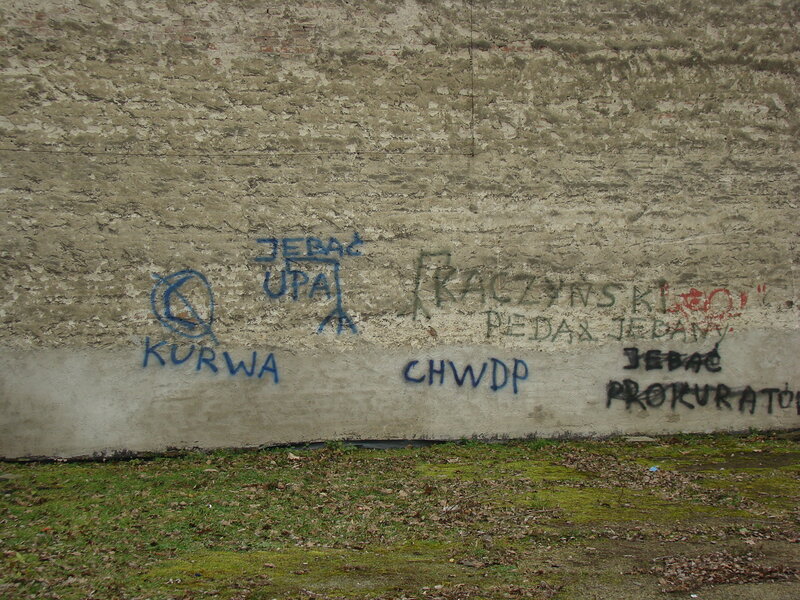
By the way, with the idea of trolling the potheads, we bought a T-shirt with the coat of arms of Lviv and the signature “Polish Lviv” (in Polish) from an online store of Polish ultra-rightists and wore it around the center all day. But apparently no one understood.
Lviv tram and other public transport
The Lviv tram is currently represented mostly by ancient Czech trams Tatra KT4SU; once upon a time there were more ancient T4SU, but now (and even before the Maidan) it is unrealistic to see them on the move, except perhaps in the sump of the tram park. A tram ride costs 3 UAH (about 6 rubles).
According to a long-standing tradition, only tourists pay for the tram; most locals ride as a hare. The reason for this has long been the “optimization” of the city electric transport, which, out of greed, abolished the positions of conductors. The driver sells the tickets, after which the passenger is required to validate them (yes, yes, in 2018!). It is extremely strange that composters were not decommunized.
Once every hundred years, a controller enters the tram and starts catching those who did not buy a ticket or did not validate it. This happened extremely rarely before the Maidan, and the enterprising local population even came up with many ways to save money even in these rare cases. If a person bought and validated a ticket, it was a sign of good manners to hand the ticket to another person entering when leaving, or to leave it inside the tram, thus the same ticket passed from hand to hand.
Particularly cunning citizens bought a ticket once for each train and wrote down the carriage number, thereby having a “card index” of stamped tickets for each carriage. Then the electric transport saw through this tactic and began periodically rearranging composters between cars.
An easier way is to buy a ticket, but not validate it, relying on the “maybe” that the controller will not enter this particular trip. Individuals stand right next to the composter at the ready, carefully examining those entering at each stop. More greyhound young people simply entered into an endless thieves' argument with the controllers, or threw them out of the car and continued free travel.
Old “round” Tatra (photo from the Internet)

A slightly newer, “square” Tatra.


I took a ride on one of the old Tatras. There are also new KT4Ds purchased in the German towns of Erfurt and Gera, where narrow-gauge railways still exist. Well, like new, just a little more well-maintained. Anyway, such modifications of trams have been out of production for about 30 years (at best - the oldest Tatra in Lviv has been running since 1981). Out of curiosity, I tried to find a plate with the year of manufacture of the car, which is usually attached in the cabin above the door to the driver’s cabin, but it wasn’t there. Apparently they tore it off so as not to embarrass themselves. By the way, the heating in the carriage does not work; in winter the temperature there is the same as outside. It is worth noting that trams that had long outlived their useful life even before the Maidan burned to the ground several times right on the route (without casualties).
Regarding the organization of tram traffic, nothing has changed; everything remains as disgusting as it was. Trams do not follow any schedule or timetable, so within the old center it is usually faster to walk than to wait for the tram.
The tram doors do not close tightly.

The ticket looks quite European, colorful and shiny. Which looks doubly wild against the backdrop of Soviet composters. A kind of “brilliance and poverty of courtesans.”





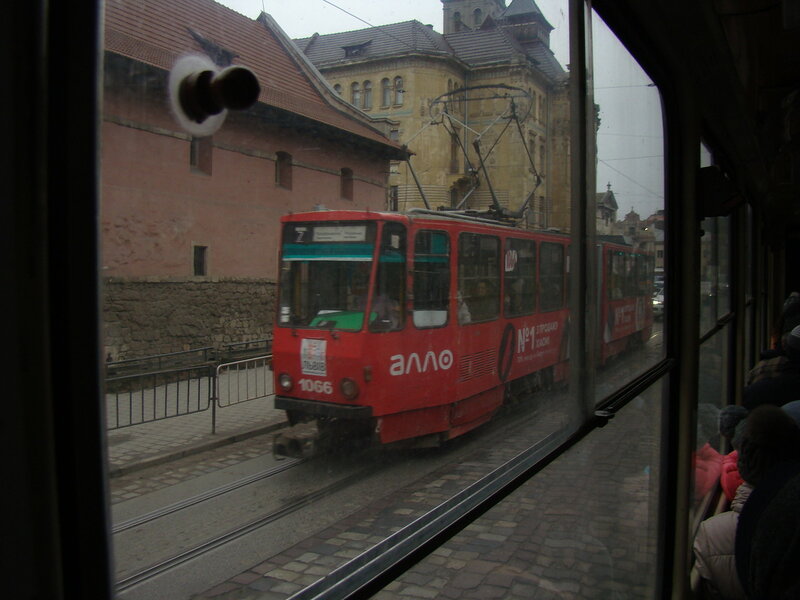
Also, such strange modifications to the Tatra were discovered (although they are quite extensive, but the source can be guessed from the rear part and the carts). There were none before the Maidan. I was unable to find information about what this modification is and who created it.
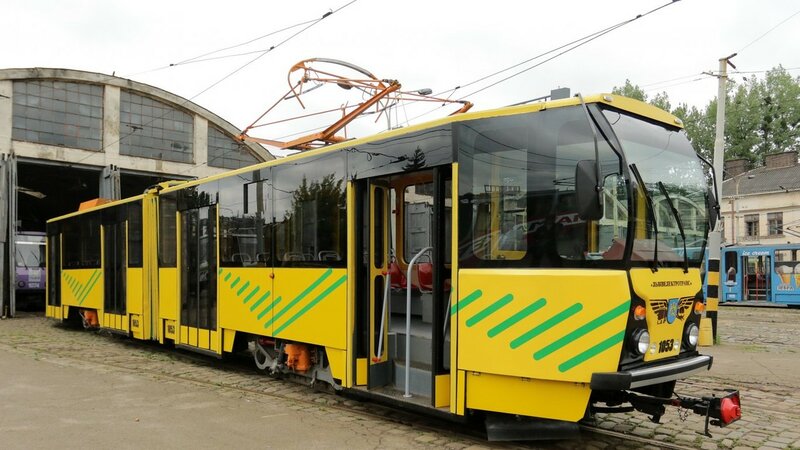
Of the modern trains, a couple of “Electrons” ply around Lviv, assembled right there at a joint Ukrainian-German enterprise. Unfortunately, there was no time to ride one, there was a lot to do. They say that before the Maidan, Electron trams were supposed to be delivered to St. Petersburg. I was unable to find information on whether Electrontrans is still alive and how actively it operates.

During post-Maidan times, Lviv completed a long-started project to expand the tram network to the Sykhov microdistrict, which I personally am extremely surprised by. After all, this is 5,5 km of tracks built from scratch and the reconstruction of most of the streets along which they passed (the width of many did not allow the placement of tracks without complete reconstruction). By Lvov standards, this is a fairly large-scale project.
An interesting historical fact: until 1920, under the rule of Austria-Hungary, there was left-hand traffic in Lviv, including trams. When the Russian army occupied Lvov in 1914-1915, the authorities wanted to change the traffic to right-hand traffic, but considered the work of altering the tram switches too painstaking. In fact, Lviv trams were traveling “in the oncoming lane” until the Poles arrived. People are often perplexed why in some old photographs of Lviv the trams seem to be running backwards - here is the explanation.
Here are a few photos from my archive of what some streets with tram tracks looked like
in the old days. The paving stones sagged under the weight of the cars (due to the layout of the city, it is impossible to prevent cars from driving along the tram tracks), and the rails remained sticking out, however, sagging at the joints. As a result, travel on such streets was extremely difficult, because trams had to slow down to avoid derailing, and cars risked being damaged by rails protruding 10 cm or having their wheels cut by chamfered and sharp edges.



As for the trolleybuses, there are still the same old Skodas, which are also probably 30-40 years old. A new Electrontrans trolleybus was discovered in the center, but I don’t know how many there are. The minibuses are represented mainly by well-worn Bogdans. The buses are still the same from Euro 2012. There is no metro in Lviv, although under the USSR they planned to remove the tram underground in some places, but they stopped the work as soon as it had time to start. I remember that somewhere in 2007, the city council came up with a project for a “light” metro in Lviv and even drew up a plan of three radial lines. A few years later the project was forgotten. They didn’t remember him even after the Maidan, which is not surprising. I think the Lviv metro will remain “the talk of the town” forever. Also, in pre-Maidan times, one rail bus route was launched, but everyone quickly got tired of the idea, and it was abolished.


Lviv airport acquired a new terminal during Euro 2012, and it is still in operation. The airport is not very busy. In view of this, there are no problems with parking - it is free and permitted anywhere. After Pulkovo, with its prison rules and thousands of fines for any action, it’s very convenient.



Lviv main station.




The station was inherited from the Psheks. Therefore, from Polish it is literally translated as “pathway palace” (dworzec kolejowy), and the square near the station is, therefore, Dvortsovaya (hello to St. Petersburg). There was no restoration or repair of the long-decayed square or the access street to the station either after the Maidan or during Independence. The problem is that there is rumored to be a low-intensity internecine war over this territory. (As of peacetime) the Railways had all the means to repair the station area, but at the same time demanded it at its disposal. The municipality did not want to give so much land to the UZD, but at the same time it did not have the means or desire to repair it. This is the status quo that has led to the fact that railway passengers in Lviv are greeted by a broken square and the same road, which literally after 500 meters ends with smooth, renovated streets.

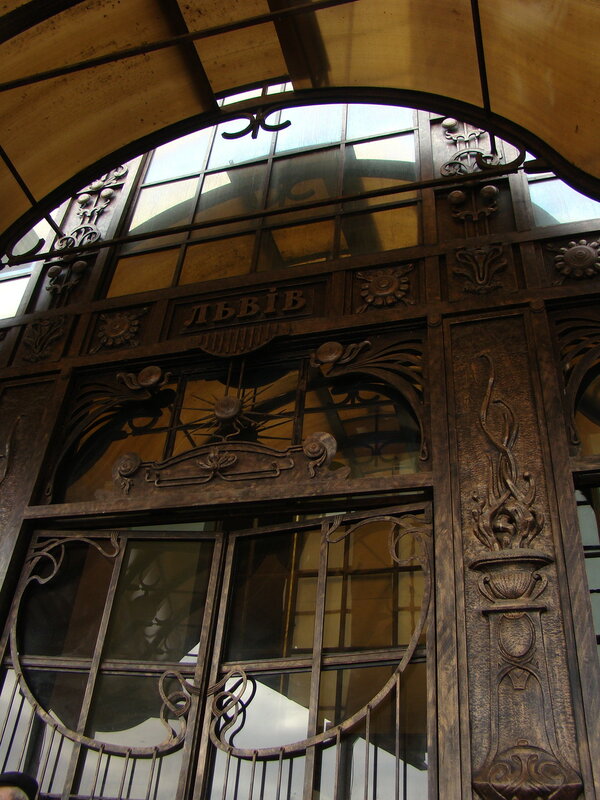


I was extremely surprised that the Moscow-Lviv train is still running. On the other hand, if it were abolished, the marginal chant “Suitcase-Station-Russia” would lose its meaning.



On the far platform stood a lonely train to Ternopil. She looks extremely depressed. It was rusty to holes, and covered in some kind of residue, as if it had not been washed for many years.



Also on the platform were trains to Odessa and Zaporozhye. They threw garbage directly onto the platform. We didn't wait for the Moscow train. In general, the station was somewhat empty. The train to St. Petersburg has long been abolished.




A memorial plaque at the station, duplicated in German.

For the most part, trains in Lviv are located at a separate “suburban” station next door, but, alas, I did not have time to look there. In addition to the main station in Lviv, there are three more historical stations, which are now stations of small-town significance: Klepariv station (used mainly as a sorting station), Podzamche station and Lychakiv station (the dead-end direction to the near suburbs was abolished under the USSR and replaced by a highway, a winding line through The hilly area is used as an access road to the yeast factory, too steep turns do not allow even a two-car train to travel faster than walking speed. The station building of the Lychakiv station is used as a residential private house).
Fun fact - asking to name three historical stations in addition to the main one is an excellent “detector” of Raguli and non-native Lviv residents who are not interested in the history of the city. For many of them, in principle, the fact of the existence of any stations other than the main one is a discovery. Among the majority of the modern population, it is generally accepted that there is only one train station in Lviv.
And this is a station in the Carpathians, Skole. Unfortunately, there was no opportunity to get closer. The train is fresher, but also tired.

If you find an error, please select a piece of text and press Ctrl + Enter.



Thank you!
Now the editors are aware.